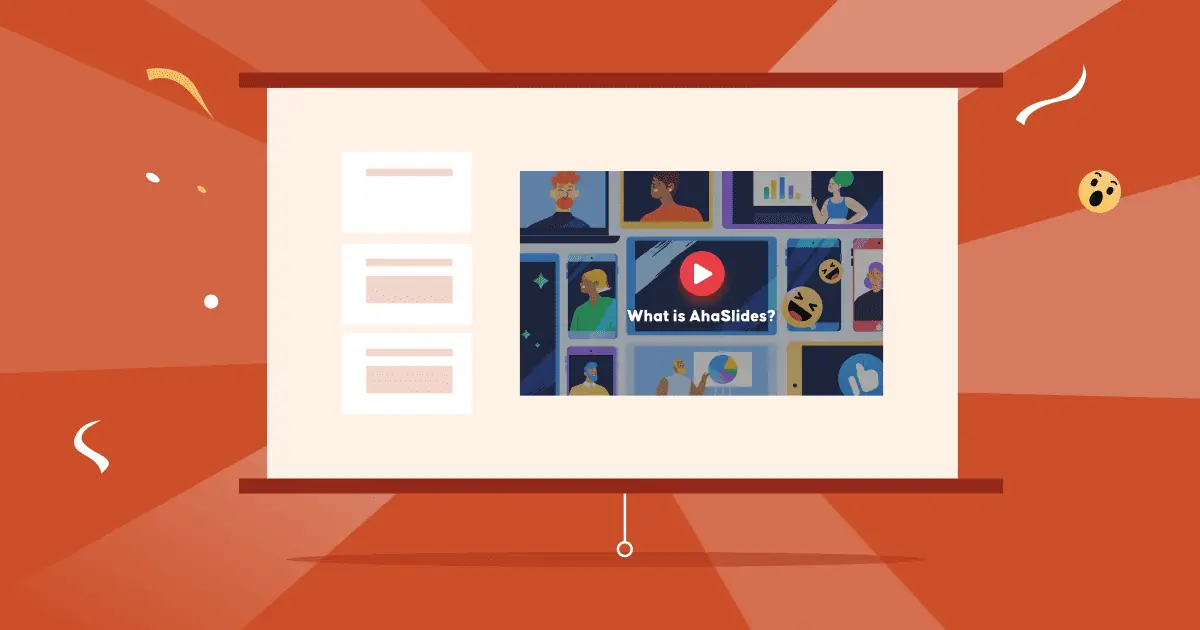Πώς να συζητήσετε για αρχάριους; Ο καβγάς είναι ένα πολύ, πολύ μεγάλο θέμα. Αν δεν το έχεις ξανακάνει ποτέ, μπορεί να σε κουράζει να σκέφτεσαι τι θα συμβεί και πώς μπορείς να αποφύγεις να φαίνεσαι εντελώς ανίδεος μπροστά σε όλους.
Υπάρχουν πολλά να μάθετε πριν μπορέσετε να βρείτε το θάρρος να σταθείτε στο βήμα. Αλλά μην ανησυχείτε. Αυτός ο οδηγός για αρχάριους σε συζητήσεις θα σας δώσει τα βήματα, τις συμβουλές και τα παραδείγματα που χρειάζεστε για να πετύχετε στην επόμενη συζήτηση. Ας δούμε, λοιπόν, αυτές τις υπέροχες συμβουλές για συζητήσεις!
Πίνακας περιεχομένων
- 7 βήματα για να οργανώσετε μια συζήτηση για αρχάριους
- 10 Συμβουλές για Νέους Συζητητές
- 6 Στυλ συζητήσεων
- 2 Παραδείγματα συζήτησης
- Περισσότερες συμβουλές με το AhaSlides
Περισσότερες συμβουλές με το AhaSlides

Ξεκινήστε σε δευτερόλεπτα.
Αποκτήστε δωρεάν πρότυπα συζητήσεων για φοιτητές. Εγγραφείτε δωρεάν και πάρτε ό,τι θέλετε από τη βιβλιοθήκη προτύπων!
🚀 Αποκτήστε δωρεάν πρότυπα ☁️
Πώς λειτουργεί μια συζήτηση για αρχάριους (σε 7 βήματα)
Πριν ξεκινήσετε να διατυπώνετε τα επιχειρήματά σας σαν επαγγελματίας, θα πρέπει να μάθετε πώς λειτουργεί μια συζήτηση για αρχάριους. Δείτε αυτά τα 7 βήματα για μια συζήτηση για αρχάριους και τι θα πρέπει να κάνετε στην πορεία, ώστε να κατανοήσετε πλήρως πώς να γίνετε καλύτερος συζητητής!
1. Ο Σκοπός Αποφασίζεται

Καθώς μπορούμε να χρησιμοποιήσουμε τις συζητήσεις σε πολλά μέρη και καταστάσεις, όπως σε σχολεία, εταιρικές συναντήσεις, συζητήσεις σε ομάδες ή πολιτικά σώματα, είναι ζωτικής σημασίας να επιλεγούν πρώτα οι κύριοι σκοποί της συζήτησης. Αυτό μπορεί να δώσει μια σαφή εικόνα για τον σχεδιασμό και την οργάνωση των συζητήσεων, επειδή υπάρχουν πολλές λεπτομέρειες που πρέπει να επεξεργαστούμε αργότερα, οι οποίες πρέπει να είναι όλες ευθυγραμμισμένες.
Έτσι, πριν από οτιδήποτε, ο συντονιστής θα απαντήσει σε αυτό – ποιοι είναι οι στόχοι αυτής της συζήτησης?
Για παράδειγμα, εάν βρίσκεστε σε ένα συζήτηση φοιτητών, οι στόχοι θα πρέπει να είναι οι ίδιοι με το μάθημά σας, οι οποίοι μπορεί να είναι η ενθάρρυνση της κριτικής σκέψης και των δεξιοτήτων δημόσιας ομιλίας των μαθητών. Εάν είναι χρήσιμο, μπορεί να είναι η απόφαση για το ποια από τις δύο ιδέες θα ακολουθήσετε.
2. Επιλέγεται η Δομή
Για να ρωτήσετε πώς να κάνετε καλό debate, χρειάζεστε μια δομή. Υπάρχουν πολλές παραλλαγές δομής debate εκεί έξω και πολλαπλές μορφές μέσα σε αυτές. Είναι σημαντικό να γνωρίζετε πρώτα ορισμένους βασικούς όρους που χρησιμοποιούνται σε πολλά συνηθισμένα είδη debate πριν προετοιμαστείτε για μια debate...
- Θέμα – Κάθε συζήτηση έχει ένα θέμα, το οποίο τυπικά ονομάζεται κίνηση or ανάλυσηΤο θέμα μπορεί να είναι μια δήλωση, μια πολιτική ή μια ιδέα, εξαρτάται από το πλαίσιο και τον σκοπό της συζήτησης.
- Δύο ομάδες - Καταφατικός (υποστήριξη της κίνησης) και Αρνητικός (αντιτίθεται στην πρόταση). Σε πολλές περιπτώσεις, κάθε ομάδα αποτελείται από τρία μέλη.
- Δικαστές or Διαιτητές: Οι άνθρωποι που κρίνουν την ποιότητα των επιχειρημάτων στα στοιχεία και τις επιδόσεις των συζητητών.
- Χρονομέτρης – Το άτομο που παρακολουθεί τον χρόνο και σταματά τις ομάδες όταν τελειώσει ο χρόνος.
- Παρατηρητές – Μπορούν να υπάρχουν παρατηρητές (κοινό) στη συζήτηση, αλλά δεν επιτρέπεται να παρέμβουν.
Για μια συζήτηση αρχαρίων, αφού λάβουν την πρόταση, οι ομάδες θα έχουν χρόνο να προετοιμαστούν. ο Καταφατικός Η ομάδα ξεκινά τη συζήτηση με τον πρώτο της ομιλητή, ακολουθούμενο από τον πρώτο ομιλητή από το Αρνητικός ομάδα. Στη συνέχεια πηγαίνει στο δεύτερο ηχείο στο Καταφατικός ομάδα, πίσω στον δεύτερο ομιλητή στο Αρνητικός ομάδα, και ούτω καθεξής.
Κάθε ομιλητής θα μιλήσει και θα παρουσιάσει τις απόψεις του στον καθορισμένο χρόνο που ορίζεται στους κανόνες της συζήτησης. Λάβετε υπόψη ότι όχι όλοι οι συζητήσεις τελειώνουν με την ομάδα Αρνητικός; μερικές φορές, ομάδα Καταφατικός θα κληθεί να τελειώσει.
Καθώς πιθανότατα είστε νέοι σε αυτό, μπορείτε να βρείτε τη διαδικασία συζήτησης για αρχάριους παρακάτωΕίναι εύκολο να το παρακολουθήσετε και μπορεί να χρησιμοποιηθεί σε πολλά διαφορετικά είδη συζήτησης.
3. Το Σχέδιο Συζήτησης Κατασκευάστηκε
Για να κυλήσει ομαλά η συζήτηση, ο συντονιστής θα έχει ένα σχέδιο που όσο το δυνατόν λεπτομερέστεραΘα πρέπει να σας ενημερώσουν για αυτό το σχέδιο, καθώς θα σας βοηθήσει να οπτικοποιήσετε τα πάντα και να μην παρεκκλίνετε από τον προσανατολισμό σας, κάτι που είναι πολύ εύκολο να κάνετε όταν συμμετέχετε σε μια συζήτηση για αρχάριους.
Ακολουθεί μια απλή λίστα ελέγχου για το τι πρέπει να περιέχει ένα σχέδιο:
- Ο σκοπός της συζήτησης
- Η ΔΟΜΗ
- Πώς θα διαμορφωθεί το δωμάτιο
- Το χρονοδιάγραμμα και το χρονοδιάγραμμα για κάθε περίοδο
- Επίσημοι κανόνες συζήτησης και οδηγίες για τους ομιλητές και τους κριτές
- Πρότυπα σημειώσεων για τους ρόλους
- Η περίληψη για να κλείσει η συζήτηση όταν τελειώσει
4. Το δωμάτιο είναι τακτοποιημένο
Το περιβάλλον είναι απαραίτητο για μια συζήτηση, καθώς μπορεί να επηρεάσει την απόδοση των ομιλητών σε κάποιο βαθμό.
Η συζήτησή σας θα πρέπει να έχει όσο το δυνατόν πιο επαγγελματική ατμόσφαιρα. Υπάρχουν πολλοί τρόποι για να δημιουργήσετε μια αίθουσα συζήτησης, αλλά όποια διάταξη κι αν επιλέξετε, όλα θα επικεντρώνονται γύρω από την «περιοχή ομιλητών» στη μέση. Εκεί θα συμβεί όλη η μαγεία της συζήτησης.
Κάθε ομιλητής που εκπροσωπεί τις δύο ομάδες θα σταθεί στην περιοχή των ηχείων κατά τη διάρκεια της σειράς του και μετά θα επιστρέψει στη θέση του όταν τελειώσει.
Παρακάτω είναι μια δημοφιλές παράδειγμα διάταξης για μια συζήτηση για αρχάριους:
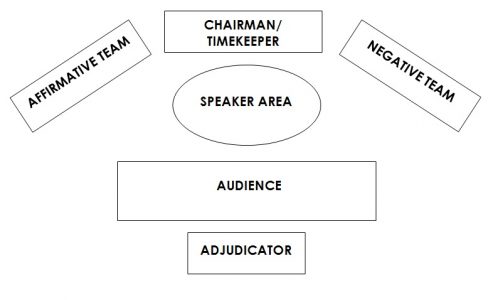
Φυσικά, υπάρχει πάντα η επιλογή να διεξαχθεί μια διαδικτυακή συζήτηση. Μπορεί να δυσκολευτείτε να νιώσετε την ίδια ατμόσφαιρα σε μια διαδικτυακή συζήτηση για αρχάριους, αλλά υπάρχουν μερικοί τρόποι για να την κάνετε πιο ενδιαφέρουσα:
- Προσαρμογή φόντου: Κάθε ρόλος μπορεί να έχει διαφορετικό φόντο Zoom: τον οικοδεσπότη, τον χρονομέτρη, τους κριτές και κάθε ομάδα. Αυτό μπορεί να βοηθήσει στη διαφοροποίηση των ρόλων κάθε συμμετέχοντα και να εμπνεύσει κάποια υπερηφάνεια για τον ρόλο που δίνεται.
- Υποστηρικτικές συσκευές:
- Μετρών την ώραν: Ο χρόνος είναι σημαντικός σε μια συζήτηση, ειδικά για τους αρχάριους που βγαίνουν για πρώτη φορά. Ο συντονιστής σας μπορεί να αποφασίσει να παρακολουθεί τον ρυθμό σας με ένα χρονόμετρο επί της οθόνης (αν και στις περισσότερες συζητήσεις, ο χρονομέτρης απλώς σηματοδοτεί πότε απομένει 1 λεπτό ή 30 δευτερόλεπτα).
- ΗΧΗΤΙΚΑ εφε: Θυμηθείτε, αυτή είναι μόνο μια συζήτηση για αρχάριους. Μπορείτε να περιμένετε από τον διαμεσολαβητή σας να ελαφρύνει την ατμόσφαιρα με ενθαρρυντικά παλαμάκια ηχητικά εφέ όταν ένας ομιλητής τελειώνει την ομιλία του.
5. Οι ομάδες επιλέγονται
Οι ομάδες θα χωριστούν σε Καταφατικός και Αρνητικός. Συνήθως, οι ομάδες και οι θέσεις των ομιλητών σε αυτές τις ομάδες τυχαιοποιούνται, επομένως ο συντονιστής σας μπορεί να χρησιμοποιήσει ένα περιστρεφόμενο τροχό για να γίνει η διαδικασία πιο συναρπαστική και συναρπαστική.
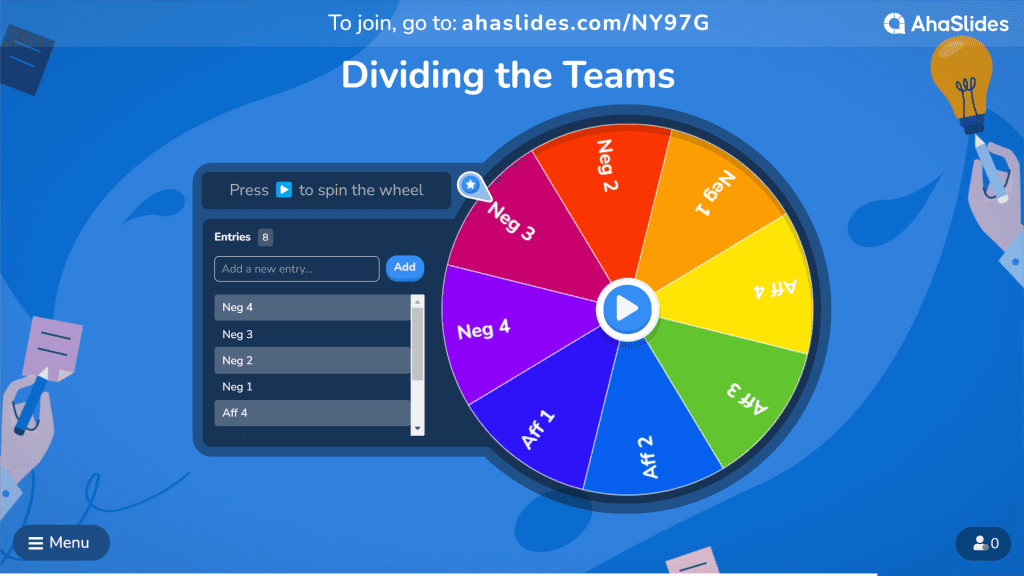
Αφού επιλεγούν οι δύο ομάδες, θα ανακοινωθεί η πρόταση και θα σας δοθεί λίγος χρόνος για να προετοιμαστείτε, ιδανικά μία ώρα.
Σε αυτό το διάστημα, ο συντονιστής θα επισημάνει πολλούς διαφορετικούς πόρους, ώστε οι ομάδες να μπορούν να κατανοήσουν το πλαίσιο και τα προβλήματα για να κάνουν πιο δυνατά σημεία. Όσο περισσότερα γνωρίζετε, τόσο πιο έντονη είναι η συζήτηση.
6. Ξεκινά η συζήτηση
Κάθε διαφορετικός τύπος συζήτησης απαιτεί άλλη μορφή και μπορεί να υπάρχουν πολλές παραλλαγές. Παρακάτω είναι μια πολύ δημοφιλής έκδοση που μπορεί να χρησιμοποιηθεί σε οποιαδήποτε συζήτηση για αρχάριους.
Κάθε ομάδα έχει τέσσερις φορές να μιλήσει σε αυτή τη συζήτηση, επομένως είναι καλύτερο να υπάρχουν 6 ή 8 ομιλητές. Στην περίπτωση των 6, δύο ομιλητές θα μιλήσουν δύο φορές.
| Ομιλία | Χρόνος | Ευθύνες των Συζητητών |
| 1η Καταφατική Κατασκευαστική | 8 λεπτά | Παρουσιάστε την κίνηση και την άποψή τους Δώστε τους ορισμούς των βασικών όρων Να παρουσιάσουν τα επιχειρήματά τους για να υποστηρίξουν την πρόταση |
| 1η Αρνητική Κατασκευαστική | 8 λεπτά | Να αναφέρουν τα επιχειρήματά τους για να αντιταχθούν στην πρόταση |
| 2η Καταφατική Κατασκευαστική | 8 λεπτά | Παρουσίαση περαιτέρω επιχειρημάτων προς υποστήριξη της πρότασης και των απόψεων της ομάδας Προσδιορίστε περιοχές συγκρούσεων Απαντήστε σε ερωτήσεις του αρνητικού ομιλητή (εάν υπάρχει) |
| 2η Αρνητική Κατασκευαστική | 8 λεπτά | Παρουσίαση περαιτέρω επιχειρημάτων κατά της πρότασης και ενίσχυση των απόψεων της ομάδας Προσδιορίστε περιοχές συγκρούσεων Απαντήστε σε ερωτήσεις του καταφατικού ομιλητή (εάν υπάρχει) |
| 1η αρνητική αντίκρουση | 4 λεπτά | Υπερασπιστείτε το Αρνητικός τα επιχειρήματα της ομάδας και να απορρίψουν τα υποστηρικτικά επιχειρήματα χωρίς να προσθέσουν νέα επιχειρήματα ή πληροφορίες |
| 1η καταφατική αντίκρουση | 4 λεπτά | Υπερασπιστείτε το Καταφατικός τα επιχειρήματα της ομάδας και να απορρίψουν τα αντίθετα επιχειρήματα χωρίς να προσθέσουν νέα επιχειρήματα ή πληροφορίες |
| 2η αρνητική αντίκρουση (Κλείσιμο Δήλωση) | 4 λεπτά | Κάντε μια δεύτερη αντίκρουση και τελικές δηλώσεις |
| 2η καταφατική αντίκρουση (Κλείσιμο Δήλωση) | 4 λεπτά | Κάντε μια δεύτερη αντίκρουση και τελικές δηλώσεις |
💡 Μπορεί να υπάρχει λίγος χρόνος προετοιμασίας πριν από τις αντιρρήσεις, ανάλογα με τους κανόνες.
Μπορείτε να δείτε ένα παράδειγμα βίντεο αυτής της μορφής εδώ κάτω.
7. Κρίνετε τη Συζήτηση
Ήρθε η ώρα οι κριτές να εργαστούν. Πρέπει να παρατηρήσουν τις συζητήσεις και την απόδοση κάθε συμμετέχοντα και στη συνέχεια να αξιολογήσουν. Αυτά είναι μερικά από τα πράγματα που θα εξετάσουν στην απόδοσή σας...
- Οργάνωση και σαφήνεια – Η δομή πίσω από την ομιλία σας – έχει νόημα να την διατυπώσετε όπως την κάνατε;
- Περιεχόμενο – Αυτά τα επιχειρήματα, τα αποδεικτικά στοιχεία, την αντεξέταση και τα αντίκρουση που προσκομίζετε.
- Στυλ παράδοσης και παρουσίασης – Πώς παρουσιάζετε τα επιχειρήματά σας, συμπεριλαμβανομένης της προφορικής και σωματικής γλώσσας, του περιεχομένου των ματιών και του τόνου που χρησιμοποιείτε.
10 Συμβουλές για Νέους Συζητητές
Κανείς δεν μπορεί να κατακτήσει τα πάντα από την αρχή και αν δεν έχετε ποτέ συζητήσει στη ζωή σας, τα πράγματα δεν είναι εύκολο να ξεκινήσετε. Παρακάτω είναι 10 γρήγορες συμβουλές για να ανακαλύψετε πώς να συζητάτε αποτελεσματικά και να πηγαίνετε μαζί με τους αρχάριους σε κάθε συζήτηση.
#1 - Η προετοιμασία είναι το κλειδί – Ερευνήστε το θέμα πολύ εκ των προτέρων για να λάβετε όχι μόνο βασικές πληροφορίες, αλλά και εμπιστοσύνη. Αυτό μπορεί να βοηθήσει τους αρχάριους συζητητές να κατανοήσουν καλύτερα τα ζητήματα για να είναι καλοί αρχάριοι αντιρρήσεων, στη συνέχεια να συντάξουν τα επιχειρήματά τους, να βρουν στοιχεία και να αποφύγουν να πάνε σε τρύπες από κουνέλι. Κάθε συζητητής θα πρέπει να περιγράψει τα πάντα σε σημεία (ιδανικά 3 σημεία για 3 επιχειρήματα) για να τακτοποιήσει καλύτερα τις ιδέες και να δει τη «μεγάλη εικόνα» της ομιλίας του.
#2 - Κρατήστε τα πάντα στο θέμα – Μία από τις αμαρτίες της συζήτησης είναι η εκτροπή από τον στόχο, καθώς σπαταλά πολύτιμο χρόνο ομιλίας και αποδυναμώνει το επιχείρημα. Δώστε προσοχή στα περιγράμματα και τα κύρια σημεία για να βεβαιωθείτε ότι ακολουθούν το θέμα και αντιμετωπίζουν τα σωστά προβλήματα.
#3 - Διατυπώστε τις παρατηρήσεις σας με παραδείγματα – Το να έχετε παραδείγματα κάνει τις προτάσεις σας για τη συζήτηση πιο πειστικές και επίσης, οι άνθρωποι βλέπουν τα πράγματα πιο καθαρά, όπως αυτό παράδειγμα παρακάτω…
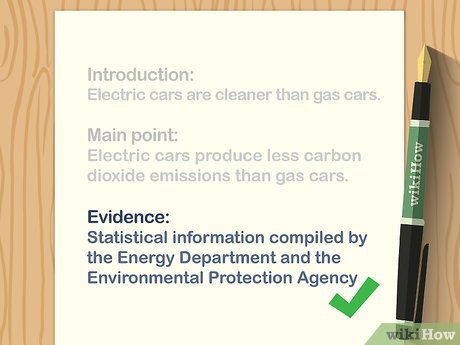
#4 - Προσπαθήστε να σκέφτεστε όπως οι αντίπαλοι – Ενώ αναθεωρείτε ιδέες, σκεφτείτε σημεία που μπορεί να θέσει η αντίπαλη πλευρά. Προσδιορίστε μερικά και γράψτε έναν νοητικό χάρτη με τις αντικρούσεις που θα μπορούσατε να προσφέρετε εάν do καταλήξετε να αναφέρετε αυτά τα σημεία.
#5 - Βάλε ένα ισχυρό συμπέρασμα – Ολοκληρώστε τη συζήτηση με μερικές καλές προτάσεις, οι οποίες μπορούν τουλάχιστον να συνοψίσουν τα κύρια σημεία. Σε πολλές περιπτώσεις, οι συζητητές αρέσκονται να ολοκληρώνουν με δύναμη, με μια ποιητικά δομημένη πρόταση για να το προκαλέσουν αυτό. πτώση μικροφώνου στιγμή (δείτε ένα παράδειγμα αυτού παρακάτω).
#6 - Να είστε σίγουροι (ή να το προσποιείτε μέχρι να τα καταφέρετε!) – Ένα από τα πιο σημαντικά πράγματα για το πώς να γίνετε καλύτεροι στη συζήτηση είναι η ατμόσφαιρα. Οι συζητητές πρέπει να είναι σίγουροι για αυτά που λένε, καθώς η αλαζονεία έχει μεγάλη επιρροή στους κριτές και τους παρατηρητές. Φυσικά, όσο περισσότερο προετοιμάζεστε, τόσο πιο σίγουροι είστε.
#7 - Μίλα αργά – Ένα πολύ συνηθισμένο πρόβλημα των αρχάριων συζητητών είναι η ταχύτητα ομιλίας τους. Τις περισσότερες φορές, την πρώτη φορά, είναι πολύ γρήγορη, γεγονός που προκαλεί άγχος τόσο στους ακροατές όσο και στον ομιλητή. Πάρτε μια ανάσα και μιλήστε αργά. Μπορεί να βγάλετε λιγότερα λόγια, αλλά αυτό που θα παράγετε θα έχει βαρύτητα.
#8 - Χρησιμοποιήστε το σώμα και το πρόσωπό σας – Η γλώσσα του σώματος μπορεί να υποστηρίξει τα επιχειρήματά σας και να δείξει αυτοπεποίθηση. Κοιτάξτε τους αντιπάλους στα μάτια, διατηρήστε μια ωραία στάση σώματος και ελέγξτε τις εκφράσεις του προσώπου (μην γίνεστε πολύ επιθετικοί) για να τραβήξετε την προσοχή.
#9 - Ακούστε προσεκτικά και κρατήστε σημειώσεις – Οι συμμετέχοντες πρέπει να δίνουν προσοχή σε κάθε ομιλία και ιδέα για να παρακολουθούν τον ρυθμό, να υποστηρίζουν τους συμπαίκτες τους και να αντικρούουν καλύτερα τους αντιπάλους. Το να έχουν σημειώσεις μπορεί να βοηθήσει πολύ, καθώς κανείς δεν μπορεί να θυμάται κάθε σημείο που πρέπει να αντικρούσει ή να αναπτύξει περαιτέρω. Θυμηθείτε να σημειώνετε μόνο τα βασικά σημεία.
#10 - Αποφύγετε τις φτηνές βολές – Εστιάστε και αντικρούστε τα επιχειρήματα των αντιπάλων σας, όχι τους ίδιους τους αντιπάλους. Κανένας συζητητής δεν πρέπει να είναι προσβλητικός προς τους άλλους. Αυτό δείχνει έλλειψη επαγγελματισμού και σίγουρα θα σας υποβαθμίσει.
6 Στυλ συζητήσεων για αρχάριους
Υπάρχουν πολλά στυλ συζητήσεων με διαφορετικές μορφές και κανόνες. Η πλήρης γνώση ορισμένων από αυτές μπορεί να βοηθήσει τους αρχάριους συζητητές να δουν τη διαδικασία και τι πρέπει να κάνουν. Εδώ είναι μερικά κοινά στυλ συζήτησης που μπορεί να δείτε στην πρώτη σας συζήτηση!
1. Συζήτηση πολιτικής – Πρόκειται για έναν κοινό τύπο που απαιτεί πολλή έρευνα. Η συζήτηση περιστρέφεται γύρω από το αν θα θεσπιστεί ή όχι μια συγκεκριμένη πολιτική και συνήθως με τη μορφή ομάδας δύο ατόμων επιπλέον. Συζήτηση πολιτικής Χρησιμοποιείται σε πολλά σχολεία επειδή είναι πρακτικό και οι κανόνες είναι πιο εύκολο να ακολουθηθούν από άλλους τύπους.
2. Κοινοβουλευτική συζήτηση – Αυτό το στυλ συζήτησης βασίζεται στο βρετανικό μοντέλο διακυβέρνησης και στις συζητήσεις στο Βρετανικό Κοινοβούλιο. Αρχικά υιοθετήθηκε από βρετανικά πανεπιστήμια και τώρα αποτελεί το επίσημο στυλ συζήτησης πολλών μεγάλων διαγωνισμών συζήτησης, όπως το Παγκόσμιο Πρωτάθλημα Πανεπιστημιακής Σκέψης και το Ευρωπαϊκό Πρωτάθλημα Πανεπιστημιακής Σκέψης. Μια τέτοια συζήτηση είναι έξυπνη και σύντομη από την παραδοσιακή. πολιτική συζήτηση, καθιστώντας το κατάλληλο για πολλές περιπτώσεις, από τα γυμνάσια μέχρι τα πανεπιστήμια.
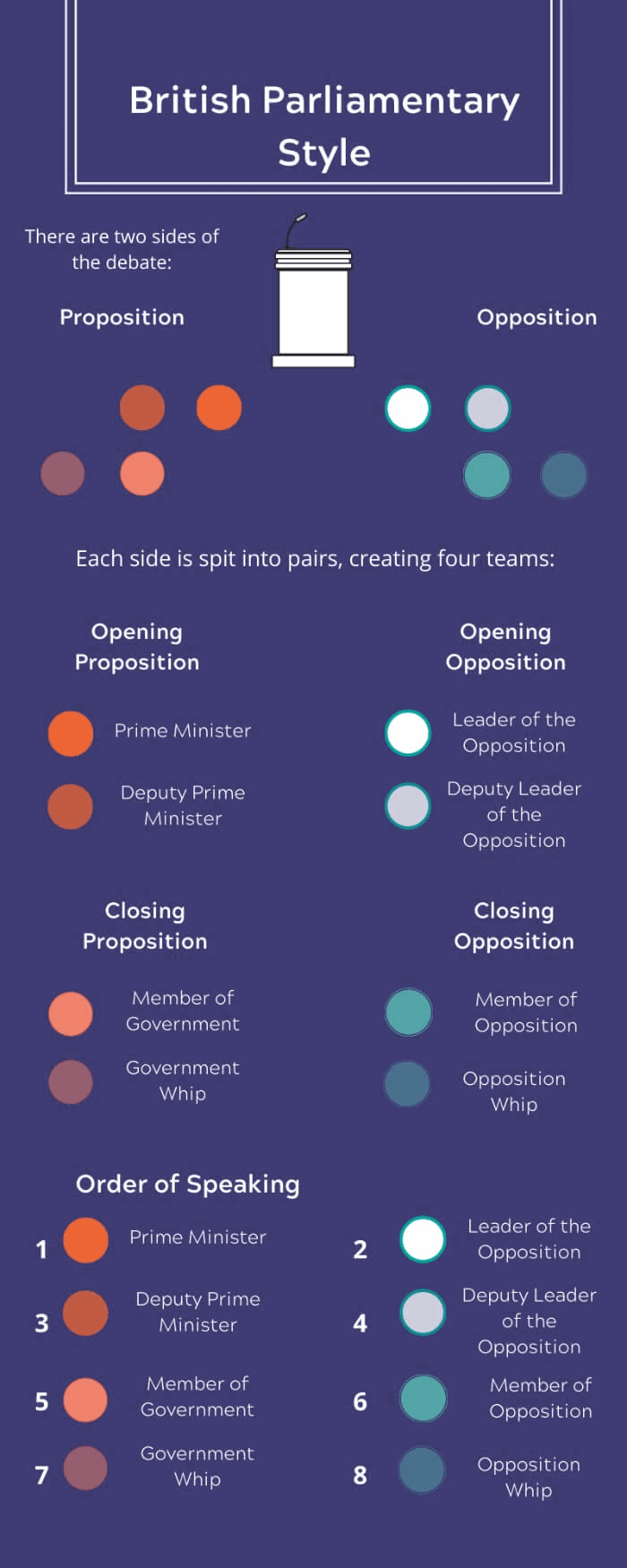
3. Δημόσια συζήτηση στο φόρουμ – Σε αυτό το στυλ, δύο ομάδες συζητούν κάποια «καυτά» και αμφιλεγόμενα θέματα ή ζητήματα τρέχουσας επικαιρότητας. Αυτά τα θέματα είναι αυτά για τα οποία πιθανότατα έχετε ήδη μια γνώμη, επομένως αυτό το είδος συζήτησης είναι πιο προσιτό από ένα πολιτική δημόσια συζήτηση.
4. Λίνκολν Ντάγκλας δημόσια συζήτηση– Πρόκειται για ένα ανοιχτό, ατομικό στυλ συζήτησης, που πήρε το όνομά του από μια διάσημη σειρά συζητήσεων το 1858 μεταξύ των υποψηφίων για τη Γερουσία των ΗΠΑ, Αβραάμ Λίνκολν, και Στίβεν Ντάγκλας. Σε αυτό το στυλ, οι συζητητές επικεντρώνονται σε πιο βαθιά ή πιο φιλοσοφικά ερωτήματα, κυρίως σε σημαντικά ζητήματα.
5. Αυθόρμητος συζήτηση – Δύο συμμετέχοντες διαφωνούν για ένα συγκεκριμένο θέμα. Πρέπει να διατυπώσουν τα επιχειρήματά τους σε πολύ σύντομο χρονικό διάστημα και να απαντήσουν γρήγορα στις ιδέες των αντιπάλων τους χωρίς ιδιαίτερη προετοιμασία. Αυτό απαιτεί ισχυρές δεξιότητες επιχειρηματολογίας και μπορεί να βοηθήσει στην ενίσχυση της αυτοπεποίθησης και στην υπερνίκηση του τρακ.
6. Βουλευτικός δημόσια συζήτηση – Αυτό το στυλ είναι μια προσομοίωση της νομοθετικής εξουσίας των ΗΠΑ, στην οποία οι συζητητές μιμούνται τα μέλη του Κογκρέσου. Συζητούν νομοθετικά κείμενα, συμπεριλαμβανομένων νομοσχεδίων (προτεινόμενων νόμων), ψηφισμάτων (δηλώσεων θέσης). Στη συνέχεια, το εικονικό Κογκρέσο ψηφίζει για την ψήφιση του νόμου και συνεχίζει να ψηφίζει υπέρ ή κατά της νομοθεσίας.
2 Παραδείγματα συζήτησης
Εδώ έχουμε δύο παραδείγματα από κάποιες συζητήσεις για να δείτε καλύτερα πώς συμβαίνουν...
1. Συζήτηση του βρετανικού κοινοβουλίου
Αυτό είναι ένα σύντομο απόσπασμα από μια συζήτηση μεταξύ της πρώην Βρετανίδας πρωθυπουργού Τερέζα Μέι και του πρώην ηγέτη του Εργατικού Κόμματος, Τζέρεμι Κόρμπιν. Η δυναμική ατμόσφαιρα της συζήτησης και οι έντονες διαφωνίες είναι χαρακτηριστικά αυτού του είδους της θορυβώδους συζήτησης. Επίσης, η Μέι ολοκλήρωσε την ομιλία της με μια τόσο έντονη δήλωση που έγινε ακόμη και viral!
2. Οι συζητητές
Φοιτητικές συζητήσεις γίνονται ένα ολοένα και πιο δημοφιλές φαινόμενο στο σχολείο. Ορισμένες καλογραμμένες συζητήσεις μπορούν ακόμη και να είναι τόσο συναρπαστικές όσο οι συζητήσεις από ενήλικες. Αυτό το βίντεο είναι ένα επεισόδιο από μια αγγλόφωνη βιετναμέζικη εκπομπή συζήτησης - The Debaters. Αυτοί οι μαθητές λυκείου συζήτησαν την πρόταση «Επευφημούμε την Greta Thunberg» σε μια αρκετά συνηθισμένη μορφή 3 προς 3.





